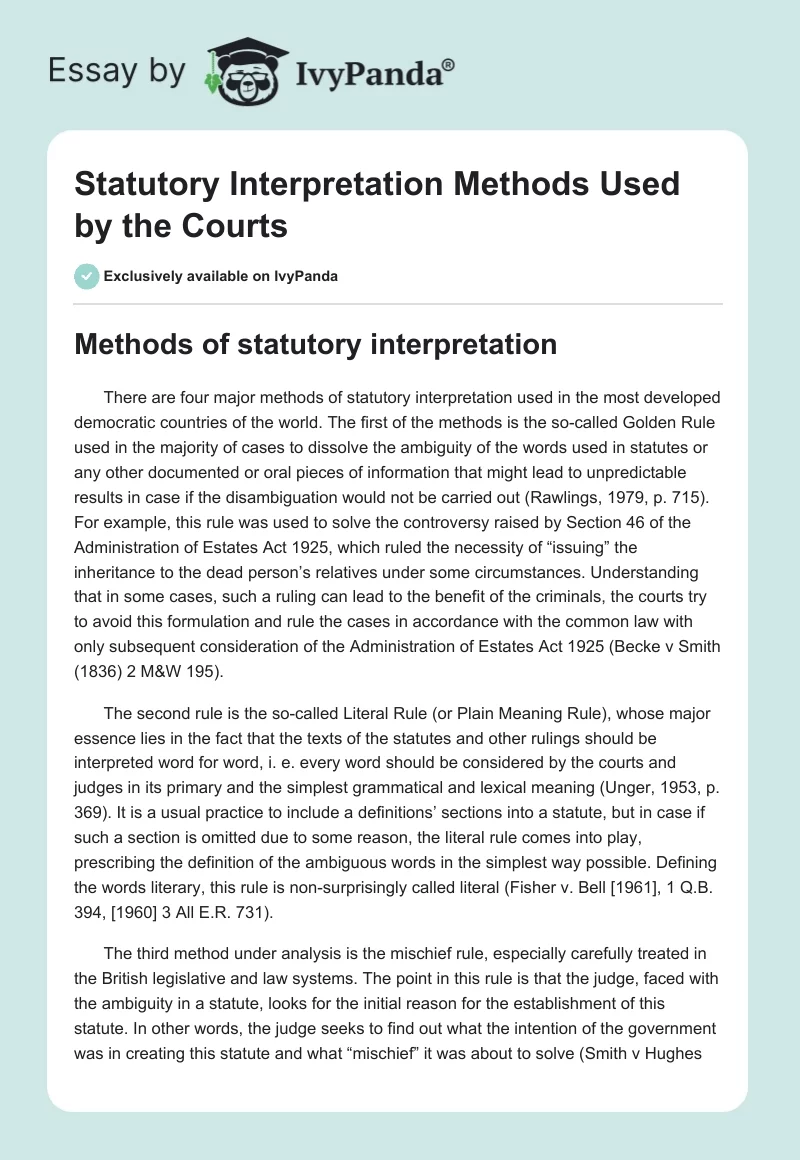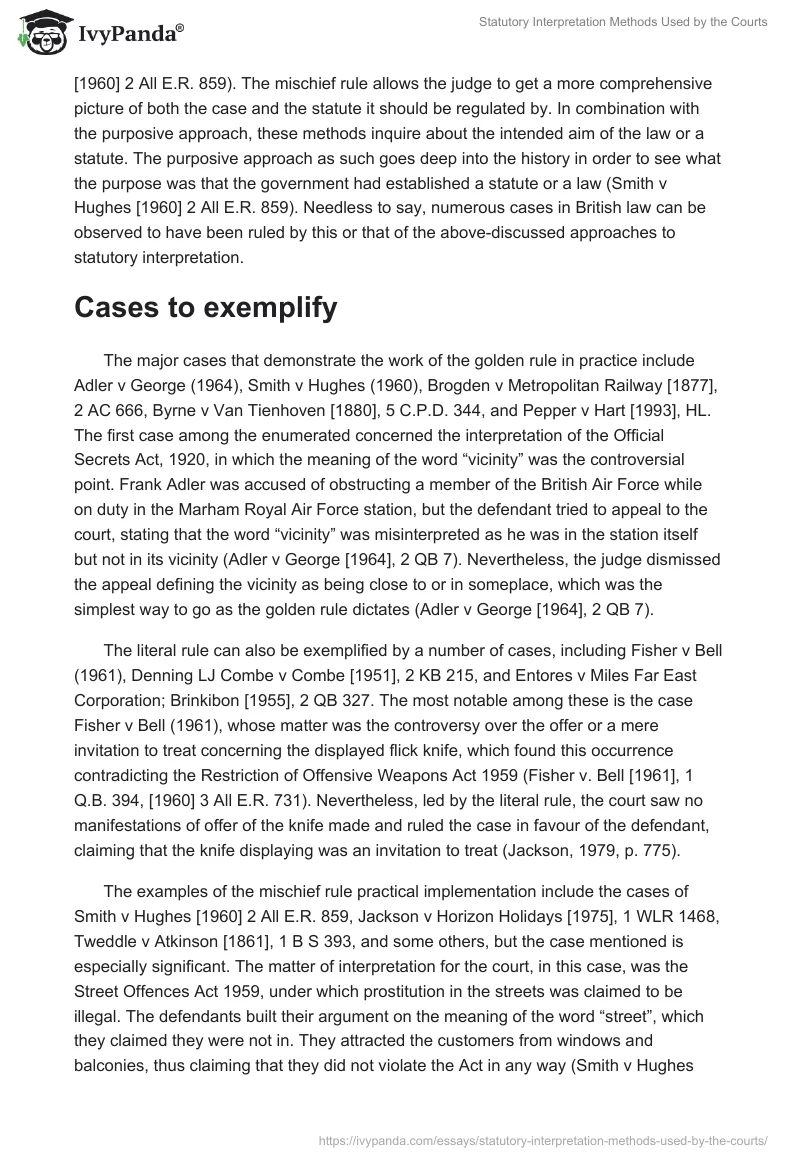Methods of statutory interpretation
There are four major methods of statutory interpretation used in the most developed democratic countries of the world. The first of the methods is the so-called Golden Rule used in the majority of cases to dissolve the ambiguity of the words used in statutes or any other documented or oral pieces of information that might lead to unpredictable results in case if the disambiguation would not be carried out (Rawlings, 1979, p. 715). For example, this rule was used to solve the controversy raised by Section 46 of the Administration of Estates Act 1925, which ruled the necessity of “issuing” the inheritance to the dead person’s relatives under some circumstances. Understanding that in some cases, such a ruling can lead to the benefit of the criminals, the courts try to avoid this formulation and rule the cases in accordance with the common law with only subsequent consideration of the Administration of Estates Act 1925 (Becke v Smith (1836) 2 M&W 195).
The second rule is the so-called Literal Rule (or Plain Meaning Rule), whose major essence lies in the fact that the texts of the statutes and other rulings should be interpreted word for word, i. e. every word should be considered by the courts and judges in its primary and the simplest grammatical and lexical meaning (Unger, 1953, p. 369). It is a usual practice to include a definitions’ sections into a statute, but in case if such a section is omitted due to some reason, the literal rule comes into play, prescribing the definition of the ambiguous words in the simplest way possible. Defining the words literary, this rule is non-surprisingly called literal (Fisher v. Bell [1961], 1 Q.B. 394, [1960] 3 All E.R. 731).
The third method under analysis is the mischief rule, especially carefully treated in the British legislative and law systems. The point in this rule is that the judge, faced with the ambiguity in a statute, looks for the initial reason for the establishment of this statute. In other words, the judge seeks to find out what the intention of the government was in creating this statute and what “mischief” it was about to solve (Smith v Hughes [1960] 2 All E.R. 859). The mischief rule allows the judge to get a more comprehensive picture of both the case and the statute it should be regulated by. In combination with the purposive approach, these methods inquire about the intended aim of the law or a statute. The purposive approach as such goes deep into the history in order to see what the purpose was that the government had established a statute or a law (Smith v Hughes [1960] 2 All E.R. 859). Needless to say, numerous cases in British law can be observed to have been ruled by this or that of the above-discussed approaches to statutory interpretation.
Cases to exemplify
The major cases that demonstrate the work of the golden rule in practice include Adler v George (1964), Smith v Hughes (1960), Brogden v Metropolitan Railway [1877], 2 AC 666, Byrne v Van Tienhoven [1880], 5 C.P.D. 344, and Pepper v Hart [1993], HL. The first case among the enumerated concerned the interpretation of the Official Secrets Act, 1920, in which the meaning of the word “vicinity” was the controversial point. Frank Adler was accused of obstructing a member of the British Air Force while on duty in the Marham Royal Air Force station, but the defendant tried to appeal to the court, stating that the word “vicinity” was misinterpreted as he was in the station itself but not in its vicinity (Adler v George [1964], 2 QB 7). Nevertheless, the judge dismissed the appeal defining the vicinity as being close to or in someplace, which was the simplest way to go as the golden rule dictates (Adler v George [1964], 2 QB 7).
The literal rule can also be exemplified by a number of cases, including Fisher v Bell (1961), Denning LJ Combe v Combe [1951], 2 KB 215, and Entores v Miles Far East Corporation; Brinkibon [1955], 2 QB 327. The most notable among these is the case Fisher v Bell (1961), whose matter was the controversy over the offer or a mere invitation to treat concerning the displayed flick knife, which found this occurrence contradicting the Restriction of Offensive Weapons Act 1959 (Fisher v. Bell [1961], 1 Q.B. 394, [1960] 3 All E.R. 731). Nevertheless, led by the literal rule, the court saw no manifestations of offer of the knife made and ruled the case in favour of the defendant, claiming that the knife displaying was an invitation to treat (Jackson, 1979, p. 775).
The examples of the mischief rule practical implementation include the cases of Smith v Hughes [1960] 2 All E.R. 859, Jackson v Horizon Holidays [1975], 1 WLR 1468, Tweddle v Atkinson [1861], 1 B S 393, and some others, but the case mentioned is especially significant. The matter of interpretation for the court, in this case, was the Street Offences Act 1959, under which prostitution in the streets was claimed to be illegal. The defendants built their argument on the meaning of the word “street”, which they claimed they were not in. They attracted the customers from windows and balconies, thus claiming that they did not violate the Act in any way (Smith v Hughes [1960] 2 All E.R. 859). However, the court decision was based on the mischief rule, according to which the mischief against which the Act was created was prostitution and the controversial word was of minor importance for the case decision. Therefore, the judge of the Smith v Hughes [1960] 2 All E.R. 859 case ruled to dismiss the defendants’ appeal (Smith v Hughes [1960] 2 All E.R. 859).
Finally, the examples of the purposive approach to the statutory interpretation include the following cases: Royal College of Nursing v DHSS (1981, HL), Pepper v Hart [1993], HL, Routledge v Grant [1828], 4 Bing 653, Dickinson v Dodds [1876], 2 Ch. D. 463, and some other. The first case is of special significance for the consideration as it concerned a vital issue of health and abortion rights (Royal College of Nursing v DHSS [1981], HL). The matter of the case was the controversy between the literal interpretation of the Abortion Act 1967, according to which only the proficient doctors could carry out abortions, and the purposive approach to the Act’s interpretation. Using the latter, the court managed to rule that the initial goal of the Act was to ensure the safety of abortions. As nurses were also able of this, the court decided to interpret the Act in the way allowing the nurses to carry out abortions as well (Royal College of Nursing v DHSS [1981], HL).
Implications for business law study
Accordingly, from the examples considered and from the conclusions that can be made from the overall examination of the statutory interpretation, it is evident that the four basic methods of the latter have considerable implications for the study of business law. In schools, colleges, and universities, students should be well aware of the legislative basis of their country as each of them can potentially become a businessperson, i.e., become subject to the business law directly (Contracts (Rights of Third Parties) Act, 1999). This is especially important in a country like the United Kingdom, where the dominant form of the court system is the precedent one. In other words, the court decisions are made on the basis of the cases that have ever been ruled by the court before. Therefore, understanding the basic principles and rules according to which those cases were decided adds to the overall awareness of the public of the principles of statutory interpretation of the law on the whole and of the business law in particular (Mortimer, 2009).
Apart from such an abstract and general implication, the consideration of the methods of statutory interpretation relates directly to business law and its study. Among the examples of the cases discussed above, there are several cases directly bound to the world of business and to the jurisdiction of British business law (Mortimer, 2009). In those cases, the precise definitions of the controversial words and notions like an offer and an invitation to treat played a crucial role. Therefore, consideration of these cases is vital for the business people to understand the alternatives they might have in case if their disputes are ruled by the court.
Finally, the study of the statutory interpretations is vital for the consideration of business laws from the consumers’ side as well. In other words, the people who have suffered any violation of their rights, in their opinion, can obtain useful information and helpful advice from the materials considered in this topic (Mortimer, 2009).
Reference List
- Adler v George [1964], 2 QB 7.
- Brogden v Metropolitan Railway [1877], 2 AC 666.
- Byrne v Van Tienhoven [1880], 5 C.P.D. 344.
- Carlill v. Carbolic Smoke Ball Co. [1893], Q.B. 256 (C.A.).
- Central London Property Trust Ltd v. High Trees House Ltd [1947], KB 130.
- Contracts (Rights of Third Parties) Act 1999.
- Denning LJ Combe v Combe [1951], 2 KB 215.
- Dickinson v Dodds [1876], 2 Ch. D. 463.
- Dunlop v Selfridge [1915], HL.
- Entores v Miles Far East Corporation; Brinkibon [1955], 2 QB 327.
- Fisher v. Bell[1961], 1 Q.B. 394, [1960] 3 All E.R. 731.
- Jackson v Horizon Holidays [1975], 1 WLR 1468.
- Jackson, BS 1979, ‘Offer and Acceptance in the Supermarket’ New Law Journal, Vol. 129, p. 775.
- Lefkowitz v Great Minneapolis Surplus Store [1957], 86 NW2d 689.
- Mortimer, T 2009, Business Law, 2nd edn. Pearson Custom Publication.
- Pepper v Hart [1993], HL.
- Pharmaceutical Society of Great Britain v. Boots Cash Chemists (Southern) Ltd. [1953], 1 QB 401.
- Rawlings, R 1979, ‘The Battle of the Forms’ Modern Law Review, Vol. 42, p.715.
- Routledge v Grant [1828], 4 Bing 653.
- Royal College of Nursing v DHSS [1981], HL.
- Shanklin Pier v Detel Products Ltd [1954], CA.
- Smith v Hughes [1960], 1 WLR 830.
- Tweddle v Atkinson [1861], 1 B S 393.
- Unger, J 1953, ‘Self-Service Shops and the Law of Contract’ Modern Law Review, Vol. 16, p.369.
- Your Rights 2009, ‘The Human Rights Act’, Yourrights.


